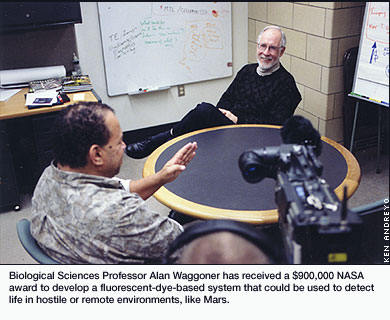|
|
||
|
|
|
 Scientist Earns NASA Award to Develop Life-Detecting Technology � Biological Sciences Professor Alan Waggoner has received a three-year $900,000 award from NASA to develop fluorescent-dye-based systems to be used in remote operations to detect life on Mars and in other hostile or distant environments. As part of the grant, Waggoner's team will develop new fluorescent dyes that bind to the common building blocks of life—DNA, lipids, carbohydrates and proteins. The grant also provides funds to develop an optical system that can spray these fluorescent dyes on a region of soil to detect life forms in the environment. This system is expected to be completed within several years. Waggoner's team will test the dyes in local environments, as well as areas hostile to life, such as the Atacama Desert in northern Chile, where relatively few pockets of life persist. Given its Mars-like terrain, the Atacama is a favorite laboratory testing ground for astrobiologists. "It's tremendously exciting to extend the work of our team and contribute to interplanetary searches for life," said Waggoner, who directs the Molecular Biosensor and Imaging Center (MBIC) at the Mellon College of Science. "We believe that these methods will provide the most sensitive means of detecting life with a remote device." The technology has potential beyond Mars, according to project manager Samuel Weinstein.
Once developed, this system could work in circumstances such as biohazardous settings or extreme environments, where an automated, unmanned device would be ideal. Developing fluorescent markers to detect life in space presents many technical challenges, said Gregory Fisher, project imaging scientist. Fluorescent markers that bind to their targets must stand out against what could be a blinding background of natural mineral luminescence. Additionally, detecting low levels of light emitted from relatively few organisms could be difficult against reflected light that is originally emitted from the optical instrument. Just as big a challenge is creating a detection system that resembles a good microscope used on earth, but one with few, if any, moveable parts. The completed system will need to focus using a camera range finder (like those found in hand-held cameras), in addition to providing some additional processing of its own camera images. "Other testing methods require considerably more sampling or are less sensitive than what we propose," Fisher said. "We don't know of other remote methods capable both of detecting low levels of micro-organisms and visualizing high levels incorporated as biofilms or colonies." Project chemist Lauren Ernst noted that Martian life forms may contain different structural components than those found on earth. "We want our reagents to visualize any form of life that might be present. We will define fluorescent probes to detect the smallest amounts of DNA, lipids, carbohydrates and proteins," Ernst said. Other members of Waggoner's team who will be performing critical research include Christoffer Lagerholm and Byron Ballou. The fluorescent marker technology proposed is based on the extensive expertise of the MBIC. Established 17 years ago with a multimillion-dollar grant from the National Science Foundation, MBIC combines research on molecular and cellular sensors along with research in imaging and computation to understand biological function. The Waggoner team is world renowned for developing widely commercialized cyanine dye fluorescent labeling reagents that have played a significant role in the human genome project and are the main dyes used to analyze gene activity in the regulation of cells and tissues. � � � � � �
�
Top�
�
�
Lauren Ward
|
|
This Issue's Headlines || Carnegie Mellon News Home || Carnegie Mellon Home |
||
 "The scientific impact of our work begins on earth, with the ability to detect very low concentrations of living and dead organisms," Weinstein said.
"The scientific impact of our work begins on earth, with the ability to detect very low concentrations of living and dead organisms," Weinstein said.